Ultrafast & Terahertz Photonics Group
|
Ultrafast optical techniques provide powerful probes of different states of matter, using light pulses that have femtosecond duration. In Warwick our activities span a number of areas:
|
Group facilitiesThe Group has labs across the campus, in the main Physics building, Materials and Analytical Sciences, and Millburn House. Read more about our experimental capabilities in terahertz science and technology. We also run the Warwick Centre for Ultrafast Spectroscopy Research Technology Platform. 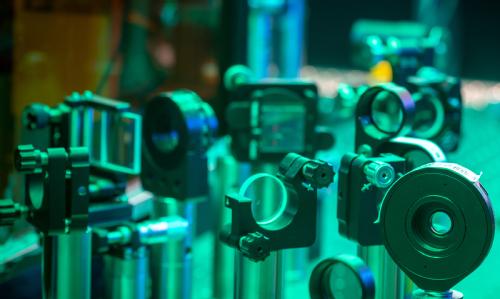
We make use of a wide range of Warwick's excellent materials analysis equipment, including X-ray diffraction, Raman spectroscopy, electron microscopy and magnetometry. |
Join the group!Please get in touch if you are interested in a PhD or MSc by Research in the group. We are also happy to support postdoctoral researchers to apply for fellowship schemes. 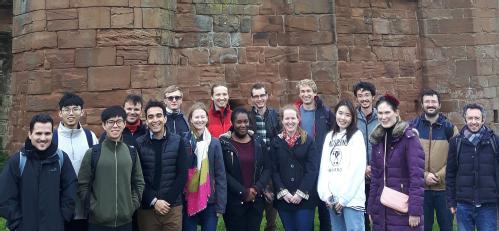
Group, Theses & PhotosContact details for our current group members and our photo gallery. For recent theses from the group, please see here. |
Research areas
Nanomaterials
We use pump/probe spectroscopy to study how light and matter interact on femtosecond to nanosecond timescales. Using visible probes we can track electronic processes, while infrared radiation lets us study vibrational states of molecules and atomic-scale defects in semiconductors.
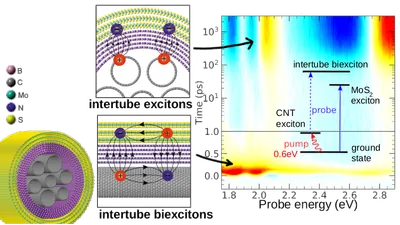
Recent papers:
Quantifying photoluminescence variability in monolayer molybdenum disulfide films grown by chemical vapour deposition
The 3237 cm−1 diamond defect: Ultrafast vibrational dynamics, concentration calibration, and relationship to the N3VH0 defect
Terahertz medical imaging
Performing in vivo studies of the THz properties of skin is a major initiative in the group, supported by the EPSRC Terabotics Programme GrantLink opens in a new window. We develop robust measurement protocols and test them on a statistically significant number of patients, cross-checking with other methods.
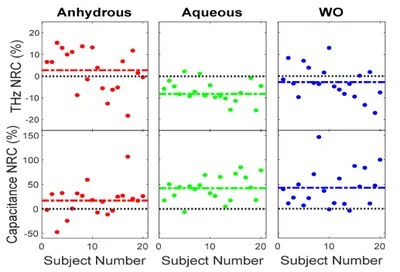
Recent papers:
Terahertz probe for real time in vivo skin hydration evaluation
Spectroscopic insight on impact of environment on natural photoprotectants
The 2023 terahertz science and technology roadmap
Semiconductors and Energy materials
A major strand of our research is to improve our knowledge of the fundamental science underpinning new semiconductor materials, such as metal-halide perovskites, which are often attractive for photovoltaic applications.
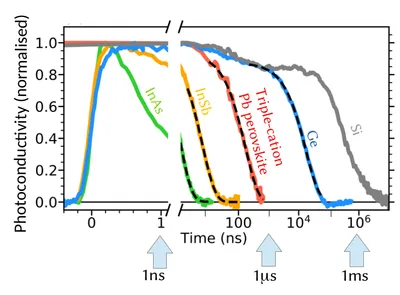
Recent papers:
Terahertz Emission via Optical Rectification in a Metal-Free Perovskite Crystal
High-bandwidth perovskite photonic sources on silicon
Resolving the Ultrafast Charge Carrier Dynamics of 2D and 3D Domains within a Mixed 2D/3D Lead-Tin Perovskite
Terahertz components, methods and techniques
We develop new THz devices and integrate them into novel systems designs that can perform THz imaging and THz spectroscopy faster, and with increased capabilities (e.g. polarisation control; robot-controlled probes).
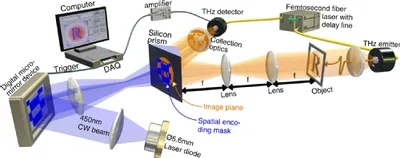
Recent papers:
Simultaneous measurement of orthogonal terahertz fields via an emission multiplexing scheme
Optimum Optical Designs for Diffraction-Limited Terahertz Spectroscopy and Imaging Systems Using Off-Axis Parabolic Mirrors
The 2023 terahertz science and technology roadmap
Recent publication highlights [filter by topic: view all | highlights | THz | perovskites | nano | biomedical]
Approaching the Shockley-Queisser limit for fill factors in lead–tin mixed perovskite photovoltaics
K.D.G.I. Jayawardena, R.M.I. Bandara, M. Monti, E. Butler-Caddle, T. Pichler, H. Shiozawa, Z. Wang, S. Jenatsch, S.J. Hinder, M.G. Masteghin, M. Patel, H.M. Thirimanne, W. Zhang, R.A. Sporea, J. Lloyd-Hughes and S. R. P. Silva
J. Mater. Chem. A 8 693 (Jan 2020) [ pdf ] [ ref ]
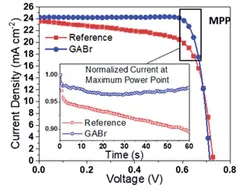 The performance of all solar cells is dictated by charge recombination. A closer to ideal recombination dynamics results in improved performances, with fill factors approaching the limits based on Shockley-Queisser analysis. It is well known that for emerging solar materials such as perovskites, there are several challenges that need to be overcome to achieve high fill factors, particularly for large area lead-tin mixed perovskite solar cells. Here we demonstrate a strategy towards achieving fill factors above 80% through post-treatment of a lead-tin mixed perovskite absorber with guanidinium bromide for devices with an active area of 0.43 cm2. This bromide post-treatment results in a more favourable band alignment at the anode and cathode interfaces, enabling better bipolar extraction. The resulting devices demonstrate an exceptional fill factor of 83%, approaching the Shockley–Queisser limit, resulting in a power conversion efficiency of 14.4% for large area devices.
The performance of all solar cells is dictated by charge recombination. A closer to ideal recombination dynamics results in improved performances, with fill factors approaching the limits based on Shockley-Queisser analysis. It is well known that for emerging solar materials such as perovskites, there are several challenges that need to be overcome to achieve high fill factors, particularly for large area lead-tin mixed perovskite solar cells. Here we demonstrate a strategy towards achieving fill factors above 80% through post-treatment of a lead-tin mixed perovskite absorber with guanidinium bromide for devices with an active area of 0.43 cm2. This bromide post-treatment results in a more favourable band alignment at the anode and cathode interfaces, enabling better bipolar extraction. The resulting devices demonstrate an exceptional fill factor of 83%, approaching the Shockley–Queisser limit, resulting in a power conversion efficiency of 14.4% for large area devices.
Ionic liquid gated carbon nanotube saturable absorber for switchable pulse generation
Y. Gladush, A. Mkrtchyan, D. Kopylova, A. Ivanenko, B. Nyushkov, S. Kobtsev, A. Kokhanovskiy, A. Khegai, M. Melkumov, M.G. Burdanova, M. Staniforth, J. Lloyd-Hughes and A.G. Nasibulin
Nano Letters 19 5836 (Aug 2019) [ pdf ] [ ref ]
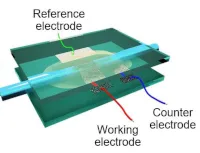 Materials with electrically tunable optical properties offer a wide range of opportunities for photonic applications. The optical properties of the single-walled carbon nanotubes (SWCNTs) can be significantly altered in the near infrared region by means of electrochemical doping. The states’ filling, which is responsible for the optical absorption suppression under doping, also alters the nonlinear optical response of the material. Here, for the first time, we report that the electrochemical doping can tailor the nonlinear optical absorption of SWCNT films and demonstrate its application to control pulsed fiber laser generation. With a pump-probe technique we show that under an applied voltage below 2 V the photo-bleaching of the material can be gradually reduced and even turned to photo-induced absorption. Furthermore, we integrated a carbon nanotube electrochemical cell on a side-polished fiber to tune the absorption saturation and implemented it into the fully polarization-maintaining fiber laser. We show that the pulse generation regime can be reversibly switched between femtosecond mode locking and microsecond Q-switching using different gate voltages. This approach paves the road towards carbon nanotube optical devices with tunable nonlinearity.
Materials with electrically tunable optical properties offer a wide range of opportunities for photonic applications. The optical properties of the single-walled carbon nanotubes (SWCNTs) can be significantly altered in the near infrared region by means of electrochemical doping. The states’ filling, which is responsible for the optical absorption suppression under doping, also alters the nonlinear optical response of the material. Here, for the first time, we report that the electrochemical doping can tailor the nonlinear optical absorption of SWCNT films and demonstrate its application to control pulsed fiber laser generation. With a pump-probe technique we show that under an applied voltage below 2 V the photo-bleaching of the material can be gradually reduced and even turned to photo-induced absorption. Furthermore, we integrated a carbon nanotube electrochemical cell on a side-polished fiber to tune the absorption saturation and implemented it into the fully polarization-maintaining fiber laser. We show that the pulse generation regime can be reversibly switched between femtosecond mode locking and microsecond Q-switching using different gate voltages. This approach paves the road towards carbon nanotube optical devices with tunable nonlinearity.
Scalable interdigitated photoconductive emitters for the electrical modulation of terahertz beams with arbitrary linear polarization
C.D.W. Mosley, M. Staniforth, A. I. Hernandez Serrano, E. Pickwell-MacPherson and J. Lloyd-Hughes
AIP Advances 9, 045323 (Apr 2019) [ pdf ] [ ref ]
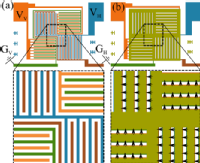 A multi-element interdigitated photoconductive emitter for broadband THz polarization rotation is proposed and experimentally verified. The device consists of separate pixels for the emission of horizontally and vertically polarized THz radiation. The broadband (0.3–5.0 THz) nature of the device is demonstrated, and the polarization angle of the generated far-field THz radiation is shown to be readily controlled by varying the relative bias voltage applied to the horizontally and vertically emitting pixels. The device is scalable in design, and with its simple method of polarization rotation it allows the modulation of the generated THz polarization at rates significantly faster than those achievable in ellipsometry systems based on mechanically rotating components.
A multi-element interdigitated photoconductive emitter for broadband THz polarization rotation is proposed and experimentally verified. The device consists of separate pixels for the emission of horizontally and vertically polarized THz radiation. The broadband (0.3–5.0 THz) nature of the device is demonstrated, and the polarization angle of the generated far-field THz radiation is shown to be readily controlled by varying the relative bias voltage applied to the horizontally and vertically emitting pixels. The device is scalable in design, and with its simple method of polarization rotation it allows the modulation of the generated THz polarization at rates significantly faster than those achievable in ellipsometry systems based on mechanically rotating components.
Design and fabrication of 3-D printed conductive polymer structures for THz polarization control
A.I. Hernandez-Serrano, Q. Sun, E.G. Bishop, E.R. Griffiths, C.P. Purssel, S.J. Leigh, J. Lloyd-Hughes and E. Pickwell-MacPherson
Optics Express 27 8 11635 (April 2019) [ pdf ] [ ref ]
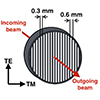
In this paper, we numerically and experimentally demonstrate the inverse polarization effect in three-dimensional (3-D) printed polarizers for the frequency range of 0.5 - 2.7 THz. The polarizers simply consist of 3-D printed strip lines of conductive polylactic acid (CPLA, Proto-Pasta) and do not require a substrate or any further metallic deposition. The experimental and numerical results show that the proposed structure acts as a broadband polarizer between the range of 0.3 THz to 2.7 THz, in which the inverse polarization effect is clearly seen for frequencies above 0.5 THz. In the inverse polarization effect, the transmission of the transverse electric (TE) component exceeds that of the TM component, in contrast to the behavior of a typical wire-grid polarizer. We show how the performance of the polarizers depends on the spacing and thickness of the CPLA structure; extinction ratios higher than 20 dB are achieved. This is the first report using CPLA to fabricate THz polarizers, demonstrating the potential of using conductive polymers to design THz components efficiently and robustly.

